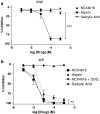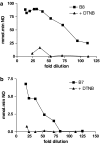Mechanism of action of novel NO-releasing furoxan derivatives of aspirin in human platelets
- PMID: 16702997
- PMCID: PMC1751793
- DOI: 10.1038/sj.bjp.0706743
Mechanism of action of novel NO-releasing furoxan derivatives of aspirin in human platelets
Abstract
Incorporation of a nitric oxide (NO)-releasing moiety in aspirin can overcome its gastric side effects. We investigated the NO-release patterns and antiplatelet effects of novel furoxan derivatives of aspirin (B8 and B7) in comparison to existing antiplatelet agents. Cyclooxygenase (COX) activity was investigated in purified enzyme using an electron paramagnetic resonance-based technique. Concentration-response curves for antiplatelet agents +/- the soluble guanylate cyclase inhibitor, ODQ (50 microM) were generated in platelet-rich plasma (PRP) and washed platelets (WP) activated with collagen using turbidometric aggregometry. NO was detected using an isolated NO electrode. The furoxan derivatives of aspirin (B8, B7) and their NO-free furazan equivalents (B16, B15; all 100 microM) significantly inhibited COX activity (P < 0.01; n = 6) in vitro and caused aspirin-independent, cGMP-dependent inhibition of collagen-induced platelet aggregation in WP. B8 was more potent than B7 (PRP IC(50) = 0.62 +/- 0.1 microM for B8; 400 +/- 89 microM for B7; P < 0.0001. WP IC(50)s = 0.6 +/- 0.1 and 62 +/- 10 microM, respectively). The NO-free furazan counterparts were less potent antiplatelet agents (WP IC(50)s = 54 +/- 3 microM and 62 +/- 10 microM, respectively; P < 0.0001, B8 vs B16). Of the hybrids investigated, only B8 retained antiplatelet activity in PRP.NO release from furoxan-aspirin hybrids was undetectable in buffer alone, but was accelerated in the presence of either plasma or plasma components, albumin (4%), glutathione (GSH; 3 microM) and ascorbate (50 microM), the effects of which were additive for B7 but not B8. NO generation from furoxans was greatly enhanced by platelet extract, an effect that could largely be explained by the synergistic effect of intracellular concentrations of GSH (3 mM) and ascorbate (1 mM). We conclude that the decomposition of furoxan-aspirin hybrids to generate biologically active NO is catalysed by endogenous agents which may instil a potential for primarily intracellular delivery of NO. The blunting of the aspirin effects of furoxan hybrids is likely to be due to loss of the acetyl moiety in plasma; the observed antiplatelet effects are thereby primarily mediated via NO release. Compounds of this class might represent a novel means of inhibiting platelet aggregation by a combination of NO generation and COX inhibition.
Figures






Similar articles
-
A potential role for extracellular nitric oxide generation in cGMP-independent inhibition of human platelet aggregation: biochemical and pharmacological considerations.Br J Pharmacol. 2005 Mar;144(6):849-59. doi: 10.1038/sj.bjp.0706110. Br J Pharmacol. 2005. PMID: 15685209 Free PMC article.
-
Mechanisms of aggregation inhibition by aspirin and nitrate-aspirin prodrugs in human platelets.J Pharm Pharmacol. 2012 Jan;64(1):77-89. doi: 10.1111/j.2042-7158.2011.01380.x. Epub 2011 Nov 10. J Pharm Pharmacol. 2012. PMID: 22150675
-
Carbon monoxide released by CORM-3 inhibits human platelets by a mechanism independent of soluble guanylate cyclase.Cardiovasc Res. 2006 Jul 15;71(2):393-401. doi: 10.1016/j.cardiores.2006.03.011. Epub 2006 Mar 22. Cardiovasc Res. 2006. PMID: 16713591
-
Aspirin and platelets: the antiplatelet action of aspirin and its role in thrombosis treatment and prophylaxis.Semin Thromb Hemost. 1997;23(4):349-56. doi: 10.1055/s-2007-996108. Semin Thromb Hemost. 1997. PMID: 9263351 Review.
-
Novel Structural Hybrids on the Base of Benzofuroxans and Furoxans. Mini-Review.Curr Top Med Chem. 2017;17(9):986-1005. doi: 10.2174/1568026616666160927145822. Curr Top Med Chem. 2017. PMID: 27697059 Review.
Cited by
-
Antiplatelet drugs--do we need new options? With a reappraisal of direct thromboxane inhibitors.Drugs. 2010 May 7;70(7):887-908. doi: 10.2165/11536000-000000000-00000. Drugs. 2010. PMID: 20426498 Review.
-
The evolving landscape for cellular nitric oxide and hydrogen sulfide delivery systems: A new era of customized medications.Biochem Pharmacol. 2020 Jun;176:113931. doi: 10.1016/j.bcp.2020.113931. Epub 2020 Mar 26. Biochem Pharmacol. 2020. PMID: 32224139 Free PMC article. Review.
-
Oxadiazole-2-oxides may have other functional targets, in addition to SjTGR, through which they cause mortality in Schistosoma japonicum.Parasit Vectors. 2016 Jan 20;9:26. doi: 10.1186/s13071-016-1301-3. Parasit Vectors. 2016. PMID: 26791563 Free PMC article.
-
Design, Synthesis, and Biological Evaluation of a Novel VEGFR-2 Inhibitor Based on a 1,2,5-Oxadiazole-2-Oxide Scaffold with MAPK Signaling Pathway Inhibition.Pharmaceuticals (Basel). 2022 Feb 18;15(2):246. doi: 10.3390/ph15020246. Pharmaceuticals (Basel). 2022. PMID: 35215358 Free PMC article.
-
Recent developments in nitric oxide donor drugs.Br J Pharmacol. 2007 Jun;151(3):305-21. doi: 10.1038/sj.bjp.0707224. Epub 2007 Apr 2. Br J Pharmacol. 2007. PMID: 17401442 Free PMC article. Review.
References
-
- ANDERSON T.J., GERHARD M.D., MEREDITH I.T., CHARBONNEAU F., DELAGRANGE D., CREAGER M.A., SELWYN A.P., GANZ P. Systemic nature of endothelial dysfunction in atherosclerosis. Am. J. Cardiol. 1995;75:71B–74B. - PubMed
-
- BROWN J.F., KEATES A.C., HANSON P.J., WHITTLE B.J. Nitric oxide generators and cGMP stimulate mucus secretion by rat gastric mucosal cells. Am. J. Physiol. 1993;265:G418–G422. - PubMed
-
- CAMERON A.J. Aspirin and gastric ulcer. Mayo Clin. Proc. 1975;50:565–570. - PubMed
-
- CENA C., LOLLI M.L., LAZZARATO L., GUAITA E., MORINI G., CORUZZI G., MCELROY S.P., MEGSON I.L., FRUTTERO R., GASCO A. Antiinflammatory, gastrosparing, and antiplatelet properties of new NO-donor esters of aspirin. J. Med. Chem. 2003;46:747–754. - PubMed
Publication types
MeSH terms
Substances
LinkOut - more resources
Full Text Sources
Other Literature Sources
Research Materials

